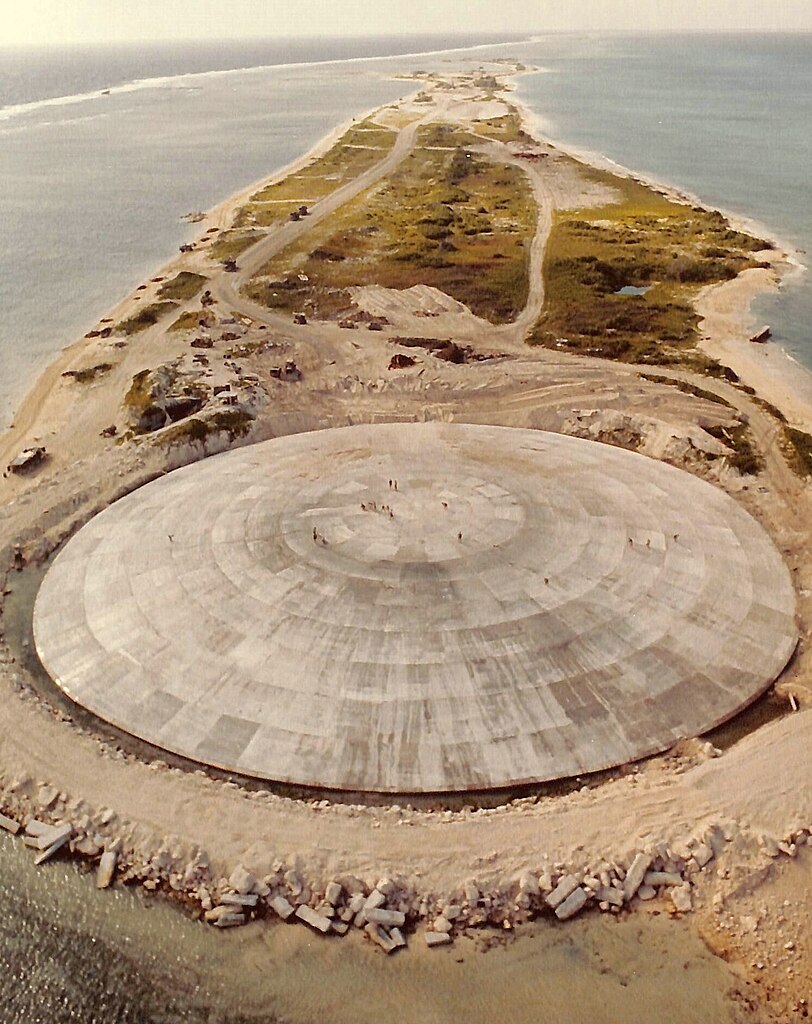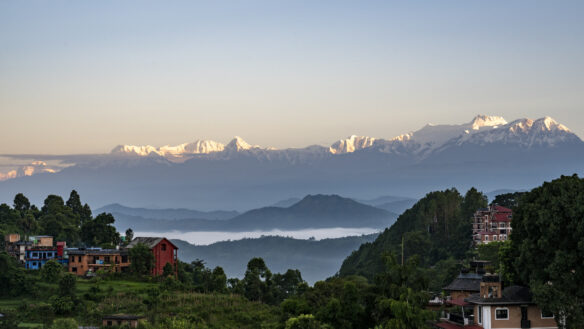Excerpt:
New satellite-based research reveals how land along the coast is slumping into the ocean, compounding the danger from global sea level rise.
A new report says melting ice sheets and rising seas could disturb waste from U.S. nuclear projects in Greenland and the Marshall Islands.
Ariana Tibon was in college at the University of Hawaiʻi in 2017 when she saw the photo online: a black-and-white picture of a man holding a baby. The caption said: “Nelson Anjain getting his baby monitored on March 2, 1954, by an AEC RadSafe team member on Rongelap two days after ʻBravo.ʻ”
Tibon had never seen the man before. But she recognized the name as her great-grandfatherʻs. At the time, he was living on Rongelap in the Marshall Islands when the U.S. conducted Castle Bravo, the largest of 67 nuclear weapon tests there during the Cold War. The tests displaced and sickened Indigenous people, poisoned fish, upended traditional food practices, and wrought cancers and other negative health repercussions that continue to reverberate today.
A federal report by the Government Accountability Office published last month examines what’s left of that nuclear contamination, not only in the Pacific but also in Greenland and Spain. The authors conclude that climate change could disturb nuclear waste left in Greenland and the Marshall Islands. “Rising sea levels could spread contamination in RMI, and conflicting risk assessments cause residents to distrust radiological information from the U.S. Department of Energy,” the report says…
Nathan Anderson, a director at the Government Accountability Office, said that the United States’ responsibilities in the Marshall Islands “are defined by specific federal statutes and international agreements.” He noted that the government of the Marshall Islands previously agreed to settle claims related to damages from U.S. nuclear testing.
To Tibon, who is back home in the Marshall Islands and is currently chair of the National Nuclear Commission, the fact that the report’s only recommendation is a new communications strategy is mystifying. She’s not sure how that would help the Marshallese people.
“What we need now is action and implementation on environmental remediation. We don’t need a communication strategy,” she said. “If they know that it’s contaminated, why wasn’t the recommendation for next steps on environmental remediation, or what’s possible to return these lands to safe and habitable conditions for these communities..?”
See Also:
Los Angeles Times (12-30-2019):
New U.S. law requires probe of Marshall Islands nuclear dump threatened by rising seas
Congress is demanding that the Department of Energy investigate an aging, cracking U.S. nuclear waste dump threatened by climate change and rising seas in the Marshall Islands.
As part of the new National Defense Authorization Act, signed last week by President Trump, the energy agency must submit a report by mid-June on the risks that Runit Dome poses to the people, environment and wildlife of Enewetak lagoon — the site of 44 nuclear bomb detonations during the Cold War.
It must also include an assessment of how climate change could affect the site, although the term “climate change” was dropped as the bill moved through the Senate Armed Services Committee, which is chaired by Oklahoma’s James M. Inhofe, one of Congress’ most outspoken climate change skeptics.
According to the law, the energy agency must submit a report that includes an “assessment of how rising sea levels might affect the dome.”
The investigation was applauded by at least one representative of the Marshall Islands, which continues to contend with the radioactive legacy of U.S. nuclear testing. The island nation sits in a remote part of the central Pacific, 5,000 miles southwest of Los Angeles..
Los Angeles Times (11-10- 2019):
How the U.S. betrayed the Marshall Islands, kindling the next nuclear disaster
Here in the Marshall Islands, Runit Dome holds more than 3.1 million cubic feet — or 35 Olympic-sized swimming pools — of U.S.-produced radioactive soil and debris, including lethal amounts of plutonium. Nowhere else has the United States saddled another country with so much of its nuclear waste, a product of its Cold War atomic testing program.
Between 1946 and 1958, the United States detonated 67 nuclear bombs on, in and above the Marshall Islands — vaporizing whole islands, carving craters into its shallow lagoons and exiling hundreds of people from their homes…
Now the concrete coffin, which locals call “the Tomb,” is at risk of collapsing from rising seas and other effects of climate change. Tides are creeping up its sides, advancing higher every year as distant glaciers melt and ocean waters rise.
Officials in the Marshall Islands have lobbied the U.S. government for help, but American officials have declined, saying the dome is on Marshallese land and therefore the responsibility of the Marshallese government.
“I’m like, how can it [the dome] be ours?” Hilda Heine, the president of the Republic of the Marshall Islands, said in an interview in her presidential office in September. “We don’t want it. We didn’t build it. The garbage inside is not ours. It’s theirs…”









